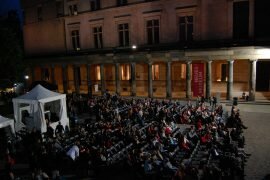The last word in the Pasolini Roma exhibition is “murder”, but having walked in the wrong way on the press day on Wednesday it was one of the first I read, weighing my entire experience with the thought that this master of European post war culture was cut, violently, short.
Pier Paulo Pasolini, born in Bologna in 1922, was a great many impressive things. Although now chiefly celebrated for his work in film, Pasolini was very much concerned with life outside of the pictures, distinguishing himself as a poet, a cultural and political critic, a novelist and a philosopher. Further still he was an interesting painter and graphic artist and a disturbingly handsome man.
The exhibition Pasolini Roma, curated by Alain Bergala, Jordi Balló and Gianni Borgn, and opening on the 11th September in Martin Gropius Bau, Berlin, details Pasolini’s life in Rome, beginning with his arrival, impoverished and insecure in 1950, after a scandal involving his expulsion from the communist party for ‘immoral behaviour’ and the loss of his teaching job (“I managed to survive, salvaging both things intact, namely Eros and honesty”) and finishing – how else? – with his murder twenty five years later.
Having worked out pretty quickly that I was walking contra to the stream of other bodies, I dashed through the six chronological sections which detail his phases of work and life, watching him come back to life as the pictures of him got older, his face younger, until I had righted myself and could begin, all with the anticipation of what was to come. It is an interesting way to walk through an exhibition and if that same loophole in pedestrian organisation is apparent when you visit, I advise you give it a go.
The exhibition itself is impressive in its detail and composition, giving texture to the chronology by analysing the topology of Pasolini’s Rome simultaneously. We watch and read how his poverty (shared with his mother, whom I believe he loved intensely) and his relationship to the subproletariat of the borgate where he lived (“suburbs built by fascism as concentration camps for the poor”) gave him the images to define his leftism, as would be explored in his first film Accattone (1961). It is a film of Pasolini’s romance with the destitute, as much as anything else and we learn how the Rome he saw became “divine” to him. Here we see the influence of the neorealists, Vittoria de Sica’s masterpiece (I really, really mean that) The Bicycle Thief having been released the year before Pasolini’s arrival.
As Pasolini’s career(s) developed and he moved away from Neorealism (and Rome) he became more provocative, in his images particularly, while maintaining his loyalty to the proletariat and the peasantry. He gave his support to the genuinely working class police forces, as opposed to the bourgeois students during the 1968 riots, as well as making films based on traditional folk stories making up his “Trilogy of Life”: Decameron (1971), The Canterbury Tales (1972) and Arabian Nights (1974). Here sex and shit (‘is that life?’ asks Pasolini the philosopher, ‘it’s certainly political’, replies Pasolini the political critic) are dealt with explicitly, although not exhaustively, as Salo, Pasolini’s last film, can attest to. There is a warning that the exhibit isn’t suitable for children under 18 at this point and that is no surprise: Salo is an immense film, but it hasn’t lost its potency: “To scandalise is a right, to be scandalised is a pleasure and to reject this pleasure is the mark of the true moralist.”
The exhibits are quirky at times, with clips from his films projected onto the windscreen of a Fiat 1100, or looked at through a strange window construction. The replica of Gramsci’s tomb almost compels the visitor to kneel as the voice of Pasolini (this time the poet) reads from one of his most famous pieces Gramsci’s Ashes. Companion pieces from the artists which inspired Pasolini give good tangents for later discovery too and it is always inspiring to examine a director’s notes and storyboards. Nonetheless there is a tone to the show and it is one of unrestrained awe at how a man managed so much, academically and artistically, and still managed to have what a lot of us would envy – a visceral, popular, lifestyle. In fact, if one element of Pasolini Roma comes across it is his celebrity, his influence and the admiration his contemporaries had for him.
I have been deliberately vague throughout for a reason. Pasolini was a man whose legacy ought to be popularly rediscovered. His criticisms of the bourgeois are couched in the language of the mid twentieth century, but with no real effort fit to the hyperactivity of our current mass media society. His films are challenging, excellent, and deliberately exclusionary of certain audiences – how much do we miss that now, in an era of pathetic franchises and a dearth of surprise? The exhibition deserves to be seen, not only to be reported on, as do Pasolini’s films – which are being shown again in Berlin in a companion program.
Let yourself be scandalised, so that you might go on to scandalise others.




